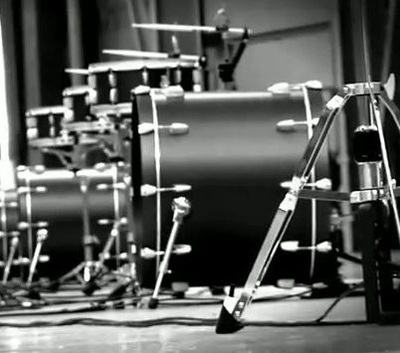|
Sometimes (most of the time), a kick drum and a bass guitar will be all over one another in a mix, and it can be really difficult for you to get a degree of separation between the two where they sound distinct, and take up their own space. I have decided to include some basic tips if (when) you come upon this issue. So, let's dive right in!
IN NO PARTICULAR ORDER (Stream of consciousness kind of stuff here folks): 1. Cut 400hz in the kick the drum (4db or greater), and then boost 400hz in the bass guitar around the same amount of db as you cut from the kick. Adjust from there. 2. Reverse the polarity of either the kick or bass (whichever sounds better). Meaning - the kick should be one polarity, and the bass should be the other. Allot of times this will get you what you need without doing anything else. 3. Add some distortion/overdrive to the bass guitar. Yes, that's right folks. A little (most of the time) is all you need. Just enough for a little hair, but more felt than heard. You may have an outboard effects processor that can do this, or you may have to use something like a Sansamp BassDriver. The BassDriver has a built-in overdrive circuit just for this purpose. EBS also makes an overdrive pedal for bass as well. 4. Change mic position of the kick drum. If the bass guitar is more boomy, then go to your kick drum & push your kick drum microphone deeper into the kick nearer the beater head. This will give it more "click," and will mostly give more separation between the two. Really, changing mic positions should be the first thing you do (or at least that's what most experienced engineers will tell you is the textbook thing to do), it's just that I forgot to put it in the Number 1 Spot! Ha! Most engineers are too lazy to actually leave the booth and would rather reach for the EQ (hence the number 1 spot above)! Zing! 5. Sometimes a little boost in the 100hz range on a bass guitar can really help too. This will give the bass guitar more of a "hard" sound that a kick drum will have a harder time reproducing (depending on the drum). This is not a rule. This could help or make it worse depending on the instruments. If you do this, you may boost around the 50-80hz range on the kick - so that as the kick is booming, the bass guitar is "thudding." Yes, "thudding" is a word because I just used it! Ha Ha ha... 6. Use compression on both (or just one) the kick drum and bass guitar. Vary the attack and release times for both within reason. Maybe a slower attack time for the kick than the bass guitar (or vice versa). You'll know when to stop when you hear it. This basically will let the initial transient through without compression and then clamp down, thus fooling the ear to give it more "punch" when you use some make up gain to equal the same amount you are actually compressing. So, if the threshold of your compressor is set to compress about 3-4 db on the gain reduction meter, then adjust the make-up gain to the same amount. Start at 20ms. on the attack, and adjust it from there. LET YOUR EARS BE YOUR GUIDE ( <<<< the best advice). 7. Change microphones (subscribe to learn about microphone types and placement, and unlock this link) on the kick drum (if you have another kick drum mic). Most churches will only have one kick drum mic, or none at all! Boooo. 8. Tell the bassist you need more high-end from his bass, because it is coming across as muddy (if this is the case). Allot of times, a bass guitar can just throw a ton of mud all over the mix. If you tell him/her that you need more "treble," they may be more resistant, than if you word it that you need more "high-end" because their bass guitar sounds like mud. "Hey bass dude, can you give me some more "high-end" because your bass sounds muddy." 9. Change out the bass guitar for a different one if you have it. 10. Parallel process your bass guitar or kick drum by multing a channel. 11. Use a drum trigger on your kick drum and blend in the triggered sample. Allot of times, this can make a really big difference in separating the kick drum from the bass. 12. Panning! If you are running a stereo mix (this can also be used in recording too), you can try panning the kick drum about 5% to the left, and then pan the bass guitar about 5% to the right. There are allot more techniques you can use to bring some separation between the kick drum and bass guitar in a mix, but the above tips should help you get there pretty quickly. One of these things may be all that you need to do; so stop when you get there, and move on to the next problem.
1 Comment
Rick Semerjian
2/10/2016 05:55:50 pm
"when you hear it, stop there & move on" GREAT advice!
Reply
Your comment will be posted after it is approved.
Leave a Reply. |
Do you like vintage recording gear and articles? You should visit our sister site: The Vintage Audio Portal!
**Advertise With Us! We have thousands of visitors a day. Contact us here to learn more.
Archives
August 2021
Categories |



